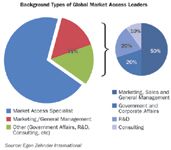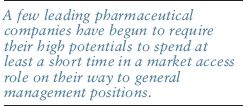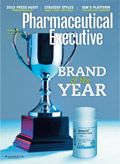Embedding Market Access in Today's Pharma Business Model
Pharmaceutical Executive
A proactive approach to talent and organization planning is the hidden trump card in prevailing with payers.
As private and government payers around the world grow more powerful, obtaining market access promptly, at an appropriate price, has become critical to company success. In the past, if a pharmaceutical product was safe and it worked, market access was usually assured. No longer. Market access today is far more challenging due to a confluence of factors: the need to contain rising costs, the proliferation of competing drugs in the same therapeutic areas, and reliance on evidence-based medicine (EBM) and health technology assessment (HTA) to drive payer decisions. In addition, growth of the generics segment and the advent of biosimilar drugs have given payers additional choices when deciding what products they will cover.
Incorporating the "voice" of market access is crucial to effective deployment of the company's most important and costly investments, including Phase III trials, M&A negotiation, and resourcing for product launches. Underestimating or misjudging payers' likely approaches to managing products can carry a price penalty reaching into the billions of dollars over a product's lifetime. In response, companies have pushed beyond standard P&R activities to embrace strategies and capabilities across a variety of functional disciplines, which together broadly represent market access.
Some of the notable advances in market access strategy over the past three to five years include sophisticated segmentation of market and payer types, new ways of engaging payers to better understand their needs, and innovative go-to-market models on the local level that bring market access together with sales and public affairs to address specific customer needs. In addition, the industry has established processes and approaches to ensuring market access input into R&D and business development efforts, as well as investing in real world data and analytics to help better define product value to payers.

Discussions we have held with 200-plus global and regional market access executives over the past 18 months confirmed that companies can better integrate market access perspectives into their global, regional, and country strategies by addressing organizational structure and processes as well as talent management—including both market access specialists and commercial leaders. However, several practical challenges that may be preventing companies from doing more on the talent and the organizational fronts have been uncovered.
These challenges include:
» Less than 10 percent of the top commercial officers and regional leaders in the 15 largest global pharmaceutical companies have spent any part of their career in a market access discipline. (Analysis covers the top commercial leaders at the top 15 pharmaceutical companies—measured by global revenues. Four to eight business unit leaders and/or regional presidents were identified at each company, depending on the organizational structures.)
» Market access leaders are often perceived as the bearers of bad news or the "naysayers." For example, defending a price point that does not match the perceived value of the asset by others in the organization, or becoming known for killing a deal.
» The vast majority of market access leaders are not integrated throughout the organization. Analysis indicates that 69 percent of them have spent on average 12 years of their careers in a market access function, out of a total average of 15 years of industry experience. (The top market access leaders at the top 25 pharmaceutical companies—measured by global revenues—were identified. We identified between one and four top leaders for each company depending upon their structure. Where there are business units, each global market access leader was included. This analysis does not include regional market access leaders—it only includes those with global responsibility.)
» Market access professionals and their teams are often not aligned with each other, as they are spread out geographically, work in different functions, and even report to different leaders, making it difficult to develop a united perspective on strategy or tactics.
Despite these challenges, there are practical steps pharmaceutical companies can take to meet the demand for high-level, broad-gauged knowledge of market access and ensure that a global or regional leadership team has the right talent and capabilities to drive successful market access strategies. Perhaps the most important is placing the market access function in the top executive team structure. Over the past five years, companies have made the market access role more senior, but these representatives still represent a small piece of the market access pie, limiting exposure to the broader perspective that the business needs.
To address the gap in market access knowledge on the executive team, organizations can do the following:
» Bring a broad range of market access experts in regularly or on an ad hoc basis to address high-profile decisions in an open environment for debate and discussion that helps move the perception of these individuals from bearers of bad news to evidence-based advocates of commercial value.
» Create opportunities for senior executives to get hands-on experience with payers. Some companies convene "market access advisors" in regions, or globally, among key payers, public policy makers, or key opinion leaders to broadly discuss the challenges in making decisions around pharmaceutical spending. And some regional GMs sponsor "market access summits" that bring together a range of functional disciplines within an organization (within and outside market access) to align around strategies. Often, a payer or payer-influencer is secured as a highlight to these sessions.
» Require CEOs and other senior leaders to meet more often with their peers in the insurance, pharmacy, pharmacy benefits management, HTA, and policy arenas. The most impactful discussions are focused on broad policy and market access trends, rather than do's and don'ts around negotiation.
» Encourage high potentials to rotate through market access roles. Recently, a few leading pharmaceutical companies have begun to require their high potentials to spend at least a short time in a market access role on their way to general management positions. Today, over a quarter (31 percent) of global market access leaders have an average of only three years of "market access" experience. While half of these executives (50%) grew up in the commercial organization (marketing, sales, or general management roles), the other half come from a variety of backgrounds, including R&D, government/corporate affairs, and consulting (see graphic).

Background Types of Global Market Access Leaders
» Be clear on the critical success factors for selecting and recruiting market access leaders. Analysis suggests that organizations highly value technical expertise in market access, measured by both depth of experience in the function and educational background and training. Over 50 percent of the top leaders are either MDs or PhDs. This is good, but organizations should be asking themselves what experiences and competencies are most critical for the market access leaders of tomorrow. Functional expertise, as measured in years of "market access" expertise within pharma, or training in a scientific discipline, are at the top of the list in seeking future talent. From a leadership perspective, global market access executives will need such critical competencies as strategic thinking, a management for results orientation, and collaboration/influencing skills, much like global marketers and commercial development managers.
» Encourage market access high potentials to move elsewhere in the organization. Giving fast trackers the opportunity early in their career to broaden experiences and skills can both infuse the organization with their knowledge as well as equip them to be better market access leaders of the future. By the time these high potential leaders have risen to a senior level market access role without functional or geographic breadth, it becomes increasingly difficult to develop them further.

From add-on to advantage
To build institutional capability on market access from the very beginning of the drug development process, companies need to ask the following questions:
» Does everyone in the commercial organization define market access the same way, and how broad is that definition?
» To what extent are market access perspectives adequately and consistently represented on the top executive team? Globally? Regionally?
» Are market access executives seen as valuable contributors in the organization today, or are they outside the important circles of influence? If the latter is true, why?
» Does or should your organization value market access experience as a part of developing high potentials? If not, why?
» Are there high potential market access specialists in your organization today who could contribute more to the organization if they were moved outside of their functional area?
» Are the skills/competencies that you are encouraging your market access teams to develop today the same that they will need for the future?
In summary, getting it right requires an enterprise-wide, holistic view of market access. Some leading companies are already moving in that direction—and more are sure to follow to ensure that their products are not only safe and effective, but also accessible and affordable.

Alyse Forcellina is a Consultant at executive search firm Egon Zehnder. She can be reached at alyse.forcellina@egonzehnder.com. Can Akannac is an Associate, Life Sciences & Healthcare Services at Egon Zehnder. He can be reacehd at can.akannac@egonzehnder.com.

The Misinformation Maze: Navigating Public Health in the Digital Age
March 11th 2025Jennifer Butler, chief commercial officer of Pleio, discusses misinformation's threat to public health, where patients are turning for trustworthy health information, the industry's pivot to peer-to-patient strategies to educate patients, and more.
Navigating Distrust: Pharma in the Age of Social Media
February 18th 2025Ian Baer, Founder and CEO of Sooth, discusses how the growing distrust in social media will impact industry marketing strategies and the relationships between pharmaceutical companies and the patients they aim to serve. He also explains dark social, how to combat misinformation, closing the trust gap, and more.